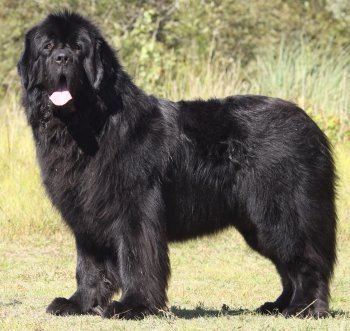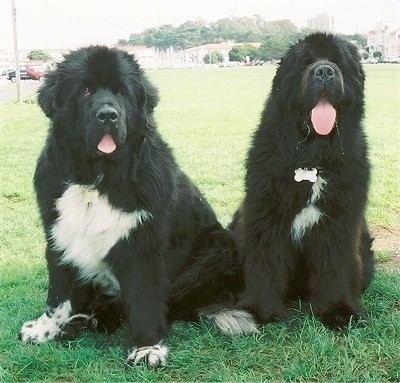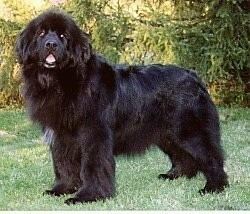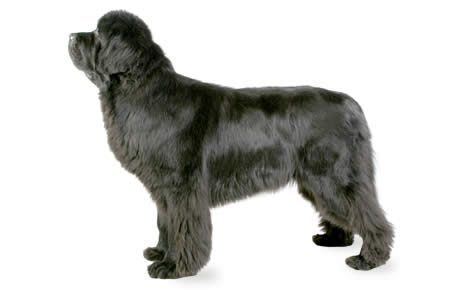Coat Thick and straight AKC Working dog ANKC Group 6 (Utility) | Litter size 4–12 pups Working dog standard Life span 8 – 10 years | |
 | ||
FCI Group 2, Section 2.2 Molossian: Mountain type #50 Height Male: 69–74 cm, Female: 63–69 cm Temperament Gentle, Sweet-Tempered, Trainable Colors Black, Grey, Brown, Black & White Weight Male: 60–70 kg, Female: 45–55 kg Similar St Bernard, Leonberger, Bernese Mountain Dog, Landseer, English Mastiff | ||
The Newfoundland dog is a large working dog. They can be either black, brown, or white-and-black (called Landseer). However, in Canada, the country of their origin, the only correct colours are either black or Landseer. They were originally bred and used as a working dog for fishermen in the Dominion of Newfoundland (which is now part of Canada). They are known for their giant size, intelligence, tremendous strength, calm dispositions, and loyalty. Newfoundland dogs excel at water rescue/lifesaving because of their muscular build, thick double coat, webbed feet, and innate swimming abilities.
Contents
- Appearance
- Temperament
- Health
- History
- Rescues
- Famous Newfoundlands
- Famous fictional Newfoundlands
- Quotations
- References

Appearance

The Newfoundlands ('Newfs' or 'Newfies') have webbed feet and a water-resistant coat. Males normally weigh 65–80 kg (143–176 lb), and females 55–65 kg (121–143 lb), placing them in the "Giant" weight range; but some Newfoundland dogs have been known to weigh over 90 kg (200 lb) – and the largest on record weighed 120 kg (260 lb) and measured over 1.8 m (6 ft) from nose to tail, ranking it among the biggest Molossers. They may grow up to 56–76 cm (22–30 in) tall at the shoulder.

The American Kennel Club (AKC) standard colors of the Newfoundland dogs are black, brown, grey, and white-and-black (sometimes referred to as Landseer). Other colors are possible but are not considered rare or more valuable. The Kennel Club (KC) permits only black, brown, and white/black; the Canadian Kennel Club (CKC) permits only black and white/black. The "Landseer" pattern is named after the artist, Sir Edwin Henry Landseer, who featured them in many of his paintings. Fédération Cynologique Internationale (FCI) consider the ECT Landseer ("European Continental Type") to be a separate breed. It is a taller, more narrow white dog with black markings not bred with a Newfoundland.

The Newfoundland's extremely large bones give it mass, while its large musculature gives it the power it needs to take on rough ocean waves and powerful tides. These dogs have huge lung capacity for swimming extremely long distances, and a thick, oily, and waterproof double coat which protects them from the chill of icy waters. The double coat makes the dog hard to groom, and also causes a lot of shedding to occur. The droopy lips and jowls make the dog drool, especially in high heat.
In the water, the dog's massive webbed paws give it maximum propulsion. The swimming stroke is not an ordinary dog paddle. Unlike other dogs, the Newfoundland moves its limbs in a down-and-out motion giving more power to every stroke.
Temperament
The Newfoundland dog is known for its calm and docile nature and its strength. They are highly loyal and make ideal working dogs. It is for this reason that this breed is known as "the gentle giant". International kennel clubs generally describe the breed as having a sweet temper. It typically has a deep bark, and is easy to train if started young. They are wonderfully good with children, but small children can get accidentally leaned on and knocked down. Newfoundlands are ideal companions in the world of therapy and are often referred to as the nanny dog. The breed was memorialized in "Nana", the beloved guardian dog in J.M. Barrie's Peter Pan. The Newfoundland in general is good with other animals, but its size can cause problems if it is not trained.
Health
There are several health problems associated with Newfoundlands. Newfoundlands are prone to hip dysplasia (a malformed ball and socket in the hip joint). They also get Elbow dysplasia, and cystinuria (a hereditary defect that forms calculi stones in the bladder). Another genetic problem is subvalvular aortic stenosis (SAS). This is a common heart defect in Newfoundlands involving defective heart valves. SAS can cause sudden death at an early age. It is similar to having a heart attack. It is common that "Newfs" live to be 8 to 10 years of age; 10 years is a commonly cited life expectancy. But, Newfoundlands can live up to 15 years old.
History
The Newfoundland shares many traits with other Mastiffs, such as the St. Bernard and English Mastiff, including stout legs, massive heads with very broad snouts, a thick bull neck, and a very sturdy bone structure. In fact, many St. Bernard Dogs have Newfoundland Dog ancestry. Newfoundlands were brought and introduced to the St. Bernard breed in the 18th century when the population was threatened by an epidemic of distemper. They share many characteristics of many mountain dog breeds such as the Great Pyrenees.
The Newfoundland breed originated in Newfoundland, and is descended from a breed indigenous to the island known as the lesser Newfoundland, or St. John's dog. The Mastiff characteristics of the Newfoundland are likely a result of breeding with Portuguese Mastiffs brought to the island by Portuguese fishermen beginning in the 16th century.
The speculation that Newfoundlands may be partly descended from big black bear dogs introduced by the Vikings in 1001 A.D. is based more in romance than in fact.
By the time colonization was permitted in Newfoundland in 1610, the distinct physical characteristics and mental attributes had been established in the Newfoundland breed. In the early 1880s, fishermen and explorers from Ireland and England traveled to the Grand Banks of Newfoundland, where they described two main types of working dog. One was heavily built, large with a longish coat, and the other medium-sized in build – an active, smooth-coated water dog. The heavier breed was known as the Greater Newfoundland, or Newfoundland. The smaller breed was known as the Lesser Newfoundland, or St. John's dog. The St. John's dog became the founding breed of the modern retrievers. Both breeds were used as working dogs to pull fish nets, with the Greater Newfoundland also being used to haul carts and other equipment.
Because of that, they were part of the foundation stock of the Leonberger (which excelled at water rescue and was imported by the Canadian government for that purpose); and the now extinct Moscow Water Dog, a failed attempt at creating a lifesaving dog by the Russian state kennel—the unfortunate outcross with the Caucasian Ovcharka begat a dog more adept at biting than rescuing.
Many tales have been told of the courage displayed by Newfoundlands in adventuring and lifesaving exploits. Over the last two centuries, this has inspired a number of artists, who have portrayed the dogs in paint, stone, bronze and porcelain. One famous Newfoundland was a dog named Seaman, who accompanied American explorers Lewis and Clark on their expedition.
The breed's working role was varied. Another famous all black Newfoundland performed as the star attraction in Van Hare's Magic Circus from 1862 and for many years thereafter in one of England's founding circus acts, traveling throughout Europe. The circus dog was known as the "Thousand Guinea Dog Napoleon" or "Napoleon the Wonder Dog." The circus owner, G. Van Hare, trained other Newfoundland dogs to perform a steeplechase routine with baboons dressed up as jockeys to ride them. Nonetheless, his "wizard dog" Napoleon was his favorite and held a special position in the Magic Circus. Napoleon would compete at jumping against human rivals, leaping over horses from a springboard, and dancing to music.
Napoleon the Wonder Dog became a wildly popular act in London from his debut at the Pavilion Theatre on April 4, 1862, and onward until his untimely death many years later when he slipped and fell during a circus practice session. At the peak of his fame, his performance was described in London's Illustrated Sporting News and Theatrical and Musical Review as follows: "Synopsis of his entertainment:-- He spells his own name with letters' also that of the Prince of Wales; and when he is asked what he would say of her Most Gracious Majesty, he puts down letters to form "God save the Queen." He plays any gentleman a game of cards, and performs the celebrated three-card trick upon which his master backs him at 100 to 1. Also "The Disappearance," a la Robin. He performs in a circus the same as a trick horse, en liberté, giving the Spanish trot to music, also leaping over bars, through balloons, with numerous other tricks of a most interesting character."
When Napoleon the Wonder Dog died, as a result of a circus accident at the age of 11 years old, his passing was announced in a number of British newspapers, including the Sheffield Daily Telegraph, which mentioned the loss on May 5, 1868, as follows: "DEATH OF A CELEBRATED FOUR-FOOTED ARTISTE. -- Mr. Van Hare's renowned dog, Napoleon, designated 'The Wizard Dog,' died on 24th ult., aged twelve years. He was a noble specimen of the Newfoundland breed (weighing near 200 lbs.) for which he took the prize at the first Agricultural Hall Dog Show. Besides his magnificent appearance and symmetry, he was the most extraordinary sagacious and highly-trained animal ever known. He is now being preserved and beautifully mounted by the celebrated naturalist, Mr. Edwin Ward. -- Era."
The breed prospered in the United Kingdom, until 1914 and again in 1939, when its numbers were almost fatally depleted by wartime restrictions. Since the 1950s there has been a steady increase in numbers and popularity, despite the fact that the Newfoundland's great size and fondness for mud and water makes it unsuitable as a pet for many households.
Rescues
During the Discovery Channel's second day of coverage of the AKC Eukanuba National Championship on December 3, 2006, anchor Bob Goen reported that Newfoundlands exhibit a very strong propensity to rescue people from water. Goen stated that one Newfoundland alone once aided the rescue of 63 shipwrecked sailors. Today, kennel clubs across the United States host Newfoundland Rescue Demonstrations, as well as offering classes in the field. Many harbor boat tours in St. John's have a dog on board for local charm as well as for passenger safety.
Further evidence of Newfoundlands' ability to rescue or support life saving activities was cited in a recent article by the BBC. The breed continues in that role today, along with the Leonberger, Labrador Retriever and Golden Retriever dogs; they are used at the Italian School of Water Rescue Dogs, Scuola Italiana Cani Salvataggio, SICS, founded by Ferruccio Pilenga.
Famous Newfoundlands
Famous fictional Newfoundlands
Quotations
"The man they had got now was a jolly, light-hearted, thick-headed sort of a chap, with about as much sensitiveness in him as there might be in a Newfoundland puppy. You might look daggers at him for an hour and he would not notice it, and it would not trouble him if he did." Jerome K. Jerome Three Men in a Boat
"Newfoundland dogs are good to save children from drowning, but you must have a pond of water handy and a child, or else there will be no profit in boarding a Newfoundland." Josh Billings
"A man is not a good man to me because he will feed me if I should be starving, or warm me if I should be freezing, or pull me out of a ditch if I should ever fall into one. I can find you a Newfoundland dog that will do as much." Henry David Thoreau Walden
"Near this spot are deposited the remains of one who possessed Beauty without Vanity, Strength without Insolence, Courage without Ferocity, and all the Virtues of Man, without his Vices. This Praise, which would be unmeaning Flattery if inscribed over human ashes, is but a just tribute to the Memory of Boatswain, a Dog." George Gordon, Lord Byron, Epitaph to a Dog.
"That boat, Rover by name, which, though now in strange seas, had often pressed the beach of Captain Delano's home, and, brought to its threshold for repairs, had familiarly lain there, as a Newfoundland dog; the sight of that household boat evoked a thousand trustful associations..." Herman Melville Benito Cereno
"Your fatuous specialist is now beginning to rebuke "secondrate" newspapers for using such phrases as "to suddenly go" and "to boldly say". I ask you, Sir, to put this man out without interfering with his perfect freedom of choice between "to suddenly go", "to go suddenly" and "suddenly to go". Set him adrift and try an intelligent Newfoundland dog in his place." George Bernard Shaw, letter to the Chronicle newspaper (1892)
